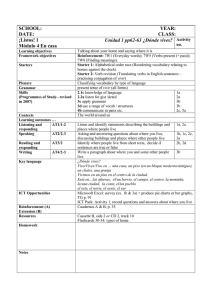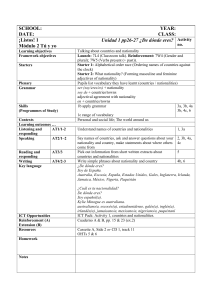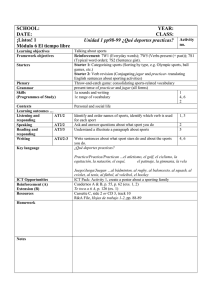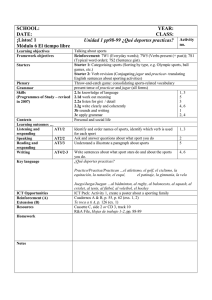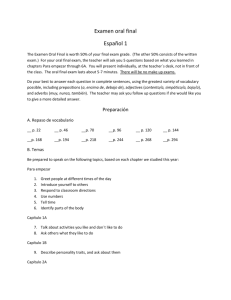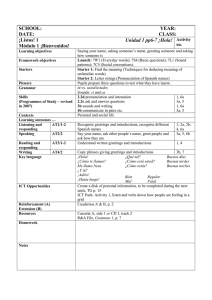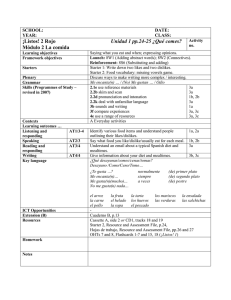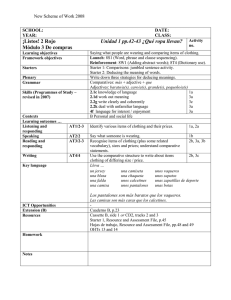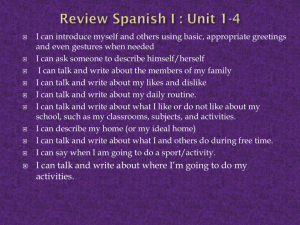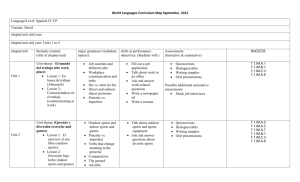¡Listos! 1 - Pearson Schools and FE Colleges
advertisement
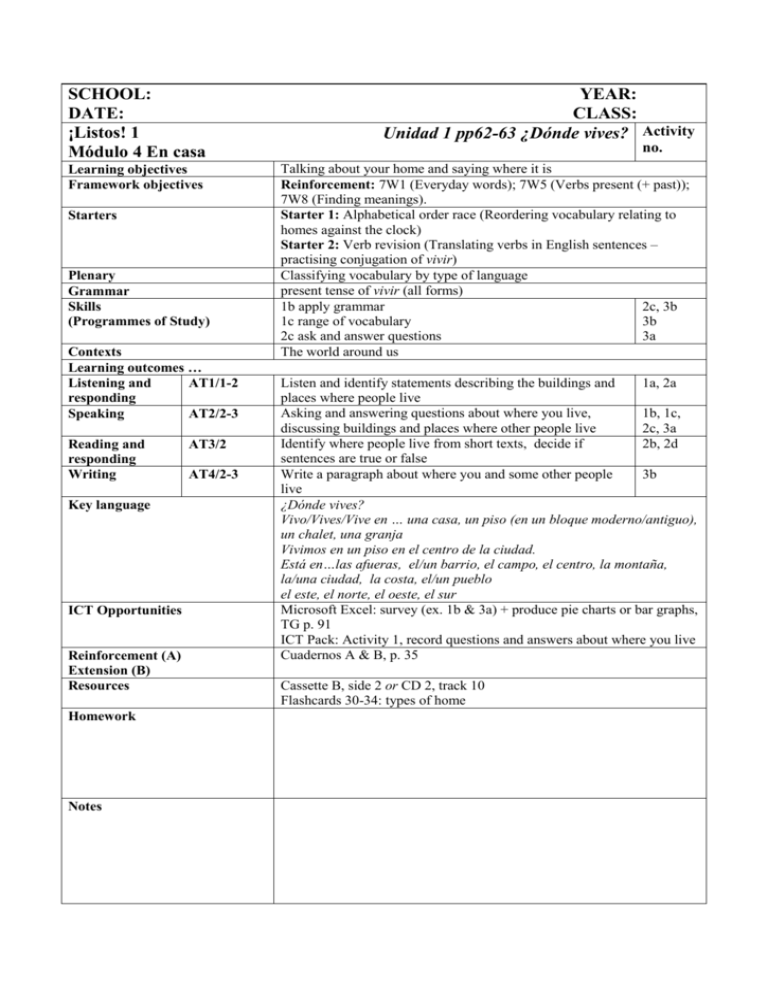
SCHOOL: DATE: ¡Listos! 1 Módulo 4 En casa Learning objectives Framework objectives Starters Plenary Grammar Skills (Programmes of Study) Contexts Learning outcomes … Listening and AT1/1-2 responding Speaking AT2/2-3 Reading and responding Writing Key language ICT Opportunities Reinforcement (A) Extension (B) Resources Homework Notes AT3/2 AT4/2-3 YEAR: CLASS: Unidad 1 pp62-63 ¿Dónde vives? Activity no. Talking about your home and saying where it is Reinforcement: 7W1 (Everyday words); 7W5 (Verbs present (+ past)); 7W8 (Finding meanings). Starter 1: Alphabetical order race (Reordering vocabulary relating to homes against the clock) Starter 2: Verb revision (Translating verbs in English sentences – practising conjugation of vivir) Classifying vocabulary by type of language present tense of vivir (all forms) 1b apply grammar 2c, 3b 1c range of vocabulary 3b 2c ask and answer questions 3a The world around us Listen and identify statements describing the buildings and 1a, 2a places where people live Asking and answering questions about where you live, 1b, 1c, discussing buildings and places where other people live 2c, 3a Identify where people live from short texts, decide if 2b, 2d sentences are true or false Write a paragraph about where you and some other people 3b live ¿Dónde vives? Vivo/Vives/Vive en … una casa, un piso (en un bloque moderno/antiguo), un chalet, una granja Vivimos en un piso en el centro de la ciudad. Está en…las afueras, el/un barrio, el campo, el centro, la montaña, la/una ciudad, la costa, el/un pueblo el este, el norte, el oeste, el sur Microsoft Excel: survey (ex. 1b & 3a) + produce pie charts or bar graphs, TG p. 91 ICT Pack: Activity 1, record questions and answers about where you live Cuadernos A & B, p. 35 Cassette B, side 2 or CD 2, track 10 Flashcards 30-34: types of home SCHOOL: DATE: ¡Listos! 1 Módulo 4 En casa YEAR: CLASS: Unidad 2 pp64-65 ¿Cómo es tu casa? Activity Learning objectives Framework objectives Describing your house Reinforcement: 7S6 (Compound sentences); 7S8 (Punctuation); 7S9 (Using simple sentences); 7T2 (Reading aloud). Starter 1: Squashed sentences (Insert spaces and punctuation into sentences relating to homes) Starter 2: Shrink-me sentences (Deleting words to find the essential part of a sentence) Grow-me sentences – embellishing basic sentences about homes with adjectives, adverbs and connectives. muy/bastante + adjective 1c range of vocab 1a,1b,1c 2c ask and answer questions 2b, 3c 5c express opinions 3c, 3d The world around us Starters Plenary Grammar Skills (Programmes of Study) Contexts Learning outcomes … Listening and AT1/2-3 responding Speaking AT2/2-4 Reading and AT3/2-4 responding Writing AT4/3-4 Key language ICT Opportunities Reinforcement (A) Extension (B) Resources Homework Notes no. Listen to check information, repeat phrases correctly, match 1b, 1c, 2a information about houses to pictures Ask and answer questions about different types of house 2b, 3c Match short sentences to pictures of houses, answer true or 1a, 3a, 3b false questions on texts about houses Write a description of your house adapting the example 3d given ¿Cómo es tu casa/piso? Mi casa es muy/bastante grande. Mi piso es antiguo. Mi chalet es de tres plantas. Mi casa es adosada. Mi piso es pequeño. ¿De cuántas plantas es? ¿Te gusta? (No) Me/Le gusta porque es moderno/a. acogedor(a), grande, antiguo/a, adosado/a, moderno/a, nuevo/a, bonito/a, pequeño/a, reformado/a, cómodo/a ¿Cuántas plantas/habitaciones tiene? Tiene cinco habitaciones. ICT Pack: Activity 2, design an advertisement for a house or flat Cuadernos A & B, p. 36 Cassette B, side 2 or CD 2, track 11 Flashcards 30-34: types of home SCHOOL: DATE: ¡Listos! 1 Módulo 4 En casa Learning objectives Framework objectives Starters Plenary Grammar Skills (Programmes of Study) Contexts Learning outcomes … Listening and AT1/1-3 responding Speaking AT2/2-3 Reading and responding Writing AT3 Key language ICT Opportunities Reinforcement (A) Extension (B) Resources Homework Notes AT4/2–4 YEAR: CLASS: Activity Unidad 3 pp66-67 El plano de mi casa no. Describing the rooms in your house Part-Launch: 7W5 (Verbs present (+ past)).Launch:7W7 (Learning about words).Reinforcement: 7T6 (Texts as prompts); 7L5 (Spontaneous talk). Starter 1: Missing vowels (Completing words for rooms of the house) Starter 2: La casa de Jennifer López (Memory game in the style of ‘I went to market and I bought…’: Fui a al casa de J-Lo y vi (ocho dormitories, etc )) Two pupils summarise what they have learnt during the lesson hay vs tiene definite articles (el/la/los/las) indefinite articles (un, una, unos, unas) 1a sounds and writing 1b, 3a 5f use language creatively 4b 2a listen for gist 2a, 3b The world around us Listen and note different rooms in a house, matching descriptions of rooms in a house to picture, identify people and the floor on which they live Asking and answering questions about rooms different houses, talking about which floor people live on / 1a, 1b, 2a, 3a, 3b 1c, 2b, 3c Complete a given text about rooms in a house, describe your 4a, 4b ideal house En mi casa/piso hay ... En la planta baja hay ... El la primera planta hay ... En el jardín hay ... un/una/dos/tres/cuatro/cinco... aseo(s), pasillo(s), cocina(s), salón/salones, comedor(es), salóncomedor(es), (cuarto de) baño, garaje(s), despacho(s), escalera(s), jardín/jardines, dormitorio(s), terraza(s) ¿Dónde vive? Vive en la primera planta el sótano, la planta baja, la primera planta, la segunda planta, la tercera planta, la cuarta planta, la quinta planta Tiene un ático/un ascensor/un sótano. Internet search followed by word-processing or desk top publishing project writing about houses, TG p. 98 Cuadernos A & B, p. 37 Te toca a ti A, p. 123 (ex.1); Te toca a ti B, p. 123 (ex. 1) Cassette B, side 2 or CD 2, track 12 R&A File, Hoja de trabajo 1, p. 56 Flashcards 35-44: rooms in the home OHTs 17 & 18 SCHOOL: DATE: ¡Listos! 1 Módulo 4 En casa Learning objectives Framework objectives Starters Plenary Grammar Skills (Programmes of Study) Contexts Learning outcomes … Listening and AT1/1– 4 responding Speaking AT2/1–2 Reading and responding Writing Key language ICT Opportunities Reinforcement (A) Extension (B) Resources Homework Notes AT3/2-4 AT4/2–4 YEAR: CLASS: Unidad 4 pp68-69 Mi dormitorio Activity no. Describing your bedroom Reinforcement: 7W1 (Everyday words); 7W6 (Letters and sounds); 7C4 (Stories and songs). Starter 1: ¿Qué soy yo? (Pupils guess the item of bedroom furniture from your description) Starter 2: Accents and pronunciation (Pronounce and insert missing accents on words relating to bedroom furniture) Recap on prepositions: play ¿Dónde está el caramelo? prepositions: delante (de), encima (de) …etc. 1a apply grammar 3b, 3c 1c range of vocabulary 1d, 2b, 4b Everyday activities Listen and note bedroom items in the correct order, listen to 1a, 1b, song and answer question in Spanish 2a, 4a Ask and answer questions about bedroom items and what 1c, 1d, 2b there is in your bedroom, use prepositions to tell a partner where to move their hands Read text and draw a plan of items in a bedroom and their 3a, 3b location, answer true/false questions about the text Correct false sentences about a bedroom, describe your 3c, 4b bedroom debajo (de), delante (de), detrás (de), encima (de), entre, a la derecha (de), a la izquierda (de), al lado (de) ¿Qué hay en tu dormitorio? En mi dormitorio hay una cama. la/una alfombra, la/una mesa, el/un armario, el/un ordenador, la/una cama, la/una pared, las cortinas, los/unos pósters, el/un equipo de música, la/una puerta, las/unas estanterías, la/una silla, la/una lámpara, la/una televisión, el/un lavabo, la/una ventana, la/una librería ICT Pack: Activity 3, describe the colour scheme in a bedroom ICT Pack: Activity 4, create a poster to teach two prepositions Cuadernos A & B, pp. 38 & 43 (ex. 1) Te toca a ti A, p. 122 (exs. 2a, 2b) Cassette B, side 2 or CD 2, track 13 Song, PB p. 69 R&A File, Hojas de trabajo 2-4, pp. 57-59 OHTs 19 & 20 SCHOOL: DATE: ¡Listos! 1 Módulo 4 En casa Learning objectives Framework objectives Starters Plenary Grammar Skills (Programmes of Study) Contexts Learning outcomes … Listening and AT1/1-2 responding Speaking AT2/1–2 Reading and responding Writing Key language ICT Opportunities Reinforcement (A) Extension (B) Resources Homework Notes AT3/2 AT4/4 YEAR: CLASS: Unidad 5 pp70-71 Por la mañana Activity no. Talking about your morning routine Reinforcement: 7W2 (High-frequency words); 7S1 (Typical word order); 7T2 (Reading aloud); 7L1 (Sound patterns). Starter 1: Noughts and crosses (Practising numbers 1-30 / telling the time) Starter 2: Back-to-front sentences (Recognising sentences relating to daily routine on a back-to-front OHT) Throw-and-catch game to practise asking questions about daily routine. reflexive verbs: levantarse, despertarse, vestirse etc. 1b apply grammar 2, 6 1c range of vocabulary 5, 6 2d initiate and develop conversations 4 Everyday activities Listen and order pictures of routine activities, note the time when activities are done Explain your daily routine, ask and answer questions about when you do different things Look at picture and choose the sentences which describe it 1a, 1b, 3 2, 4 5 Write sentences about what you do on mornings during the 6 weekend ¿A qué hora te despiertas/levantas/duchas/vistes/peinas/lavas los dientes/desayunas? ¿A qué hora desayunas? Me despierto/levanto/ducho/visto/peino/lavo los dientes/desayuno a las siete. No me despierto temprano. Me levanto tarde/temprano. (No) Desayuno. Primero me ducho y me visto. No me peino, pero me lavo los dientes. ICT Pack: Activity 5, listen to information about daily routine and note down key information Cuaderno A, pp. 39 & 43 (ex. 2) Cuarderno B, pp. 39 & 43 (exs. 2-3) Cassette B, side 2 or CD 2, track 14 R&A File, Grammar, p. 60 Flashcards 45-51: morning routine OHTs 21 & 22 SCHOOL: DATE: ¡Listos! 1 Módulo 4 En casa YEAR: CLASS: Unidad 6 pp72-73 Por la tarde Activity Learning objectives Framework objectives Talking about what you do after school Reinforcement: 7T3 (Checking before reading); 7T4 (Using resources); 7L6 (Improving speech). Starter 1: Odd one out (Looking closely at verbs used in daily routine language) Starter 2: Vowel combinations (Pronouncing words containing the vowel strings ie, io. ia, ue, ua) Discuss different approaches to reading exercises reflexive verbs: acostarse, divertirse 1b apply grammar 1d, 2b 2f adapt learned language 1a, 1c, 2a Everyday activities Starters Plenary Grammar Skills (Programmes of Study) Contexts Learning outcomes … Listening and AT1/2 responding Speaking AT2/3 Reading and AT3/2-4 responding Writing Key language ICT Opportunities Reinforcement (A) Extension (B) Resources Homework Notes AT4/3–4 no. Listen and check answers to matching activity (phrases 1b matched to photos) Ask and answer questions about after-school routine 1d Read and match sentences about daily routine to photos, 1a, 1c, 2a match questions to answers, answer true/false questions on a letter about daily routine Write a reply to a letter answering questions about daily 2b routine ¿Comes en el instituto o en casa? ¡Me divierto con mis amigos! Como en casa a la una. ¿Qué haces después de cenar? ¿A qué hora meriendas/cenas? Después de cenar, veo la televisión Meriendo/Ceno a las … ¿A qué hora te acuestas? ¿Cuándo haces los deberes? Me acuesto a las once. Hago los deberes a las … E-mail: e-mail to a Spanish person following ex. 2b, TG p. 108 ICT Pack: Activity 6, write about your evening routine Cuadernos A & B, pp. 40-42, p. 44 Te toca a ti A, p. 122 (ex. 1) Te toca a ti B, p. 123 (ex. 2, 3) ¡Extra!, PB, pp. 76-77 Cassette B, side 2 or CD 2, track 15 R&A File, Skills 1, p. 61 OHTs 21 & 22
